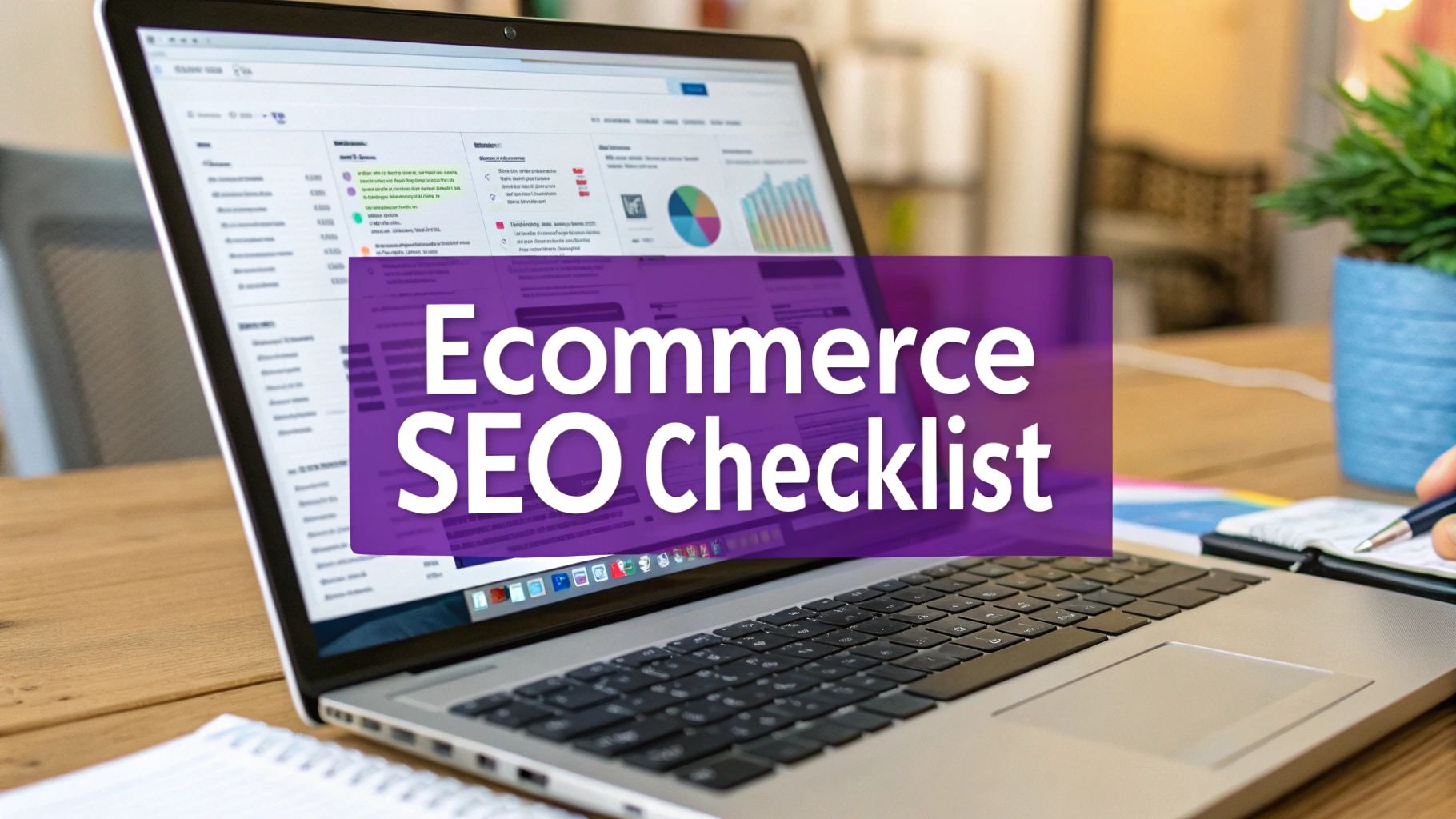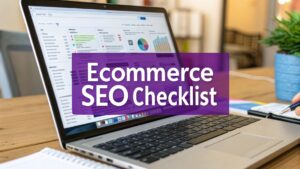In the crowded world of online retail, standing out is no longer optional—it's essential for survival. A robust Search Engine Optimisation (SEO) strategy is the engine that drives visibility, attracts high-intent customers, and ultimately, boosts your bottom line. But with countless ranking factors and algorithm updates, knowing where to focus your efforts can feel overwhelming, especially for small to medium-sized businesses in the UK.
This is where a clear, actionable plan becomes invaluable. This comprehensive ecommerce SEO checklist cuts through the noise. We've compiled 10 prioritised steps—from technical foundations like site speed and structured data to creative strategies involving product descriptions and link building—designed specifically for UK e-commerce businesses to implement immediately. Think of it as your definitive roadmap to climbing the search rankings and converting clicks into loyal customers.
Each point in this checklist is crafted to deliver tangible results, helping you optimise everything from individual product pages to your overall site architecture. For a comprehensive guide to optimising your online store, dive into these essential 10 Ecommerce SEO Best Practices for 2025 to supplement the steps outlined below. Whether you're a startup in Cambridgeshire or an established national brand, this guide will equip you with the practical knowledge needed to enhance your online presence, drive targeted traffic, and achieve sustainable growth. Let's begin building your SEO foundation.
1. Optimise Product Title Tags and Meta Descriptions
Title tags and meta descriptions are the first impressions your products make on potential customers in Google's search results. These crucial HTML elements directly influence whether a user clicks on your link or a competitor's, making their optimisation a foundational step in any ecommerce SEO checklist. They act as a concise advert for your product page, communicating its relevance and value at a glance.

Neglecting these elements is like leaving your shop window empty; it fails to attract passers-by. For small and medium-sized enterprises (SMEs), a well-crafted title and description can level the playing field, driving high-quality traffic without a significant marketing budget.
How to Implement Effective Titles and Descriptions
A winning product title tag needs to be both user-friendly and search engine-optimised. It should be unique for every product to avoid duplicate content issues and give Google clear signals about each page's specific purpose.
For Title Tags (50-60 characters):
- Structure: A common and effective formula is: Primary Keyword (Product Name) | Key Attribute/Category | Brand Name. For example,
Waterproof Hiking Boots for Men | Outdoor Footwear | TrekReady UK. - Keyword Placement: Front-load your most important keyword. Search engines give more weight to words at the beginning of the title, and users scan from left to right.
- Uniqueness: Ensure every single product page, including variants like colour or size, has a unique title tag to signal its distinct value.
For Meta Descriptions (150-160 characters):
- Focus on Value: This is your sales pitch. Highlight unique selling points (USPs) like
Free UK Delivery,Handmade in Cambridgeshire, or2-Year Warranty. - Include a Call-to-Action (CTA): Encourage clicks with action-oriented language. Use phrases like
Shop Now,Explore the Collection, orFind Your Perfect Fit. - Incorporate Secondary Keywords: Naturally weave in related keywords that didn't fit into the title, such as materials, features, or use cases. For example, a description for hiking boots might mention
Gore-Tex liningandideal for fell walking.
2. Implement Structured Data Markup (Schema.org)
Structured data, often called schema markup, is a specialised vocabulary you add to your website's HTML to help search engines read and understand your content more effectively. By providing explicit clues about the meaning of your page elements, you enable search engines to display your product information as "rich snippets" directly in the search results, making your listings far more compelling.
For an ecommerce business, this is a non-negotiable part of a modern SEO strategy. It’s the difference between a plain blue link and a visually engaging result that features star ratings, price, and stock availability. These enhancements can significantly increase click-through rates, driving more qualified traffic to your product pages without improving your ranking position itself.
How to Implement Structured Data for Products
Implementing schema doesn't have to be overly technical, as many ecommerce platforms offer plugins or built-in features to manage it. The goal is to mark up key product details using the Schema.org vocabulary, specifically the Product, Offer, and AggregateRating types.
Essential Product Schema Properties to Include:
name: The full name of your product, which should match the product page's H1 tag.image: A high-quality image URL of the product.description: A concise summary of the product.skuorgtin: A unique product identifier, crucial for Google to understand exactly what product you are selling.
For Offer and Availability Schema:
price&priceCurrency: Clearly state the price and the currency (e.g.,GBP). Ensure this always matches the price displayed on the page.availability: Use schema terms likeInStock,OutOfStock, orPreOrderto show customers the current status directly in the search results.
For Reviews and Ratings Schema:
AggregateRating: If your product has multiple reviews, use this to display the average star rating and the total number of reviews (ratingValueandreviewCount). This social proof is a powerful magnet for clicks.
After implementation, always use Google's Rich Results Test tool to validate your code and ensure it's free of errors. For a deeper dive into the specifics, you can learn more about what schema markup is and how it functions.
3. Optimise Product Page Structure and Internal Linking
A logical site structure is the digital equivalent of well-organised aisles in a physical shop. It guides both users and search engine crawlers effortlessly from broad categories to specific products. Strategic internal linking is the network of signposts that connects these aisles, distributing authority, enhancing crawlability, and creating a seamless user journey that encourages discovery and purchase.
For SMEs, a coherent structure is a powerful, cost-free asset. It helps establish topical relevance for your entire product range, making it easier for Google to understand what you sell and for customers to find what they need. A messy or flat site architecture, by contrast, confuses search engines and frustrates potential buyers, leading to poor rankings and lost sales.
How to Implement Effective Structure and Linking
A strong site architecture begins with a logical hierarchy, typically flowing from the homepage to categories, then to sub-categories, and finally to product detail pages (PDPs). This should be reinforced with a robust internal linking strategy that creates meaningful connections between pages.
For Site Structure:
- Logical Hierarchy: Organise your products into clear, intuitive categories. A good example is:
Home > Clothing > Men's > Jackets & Coats. This path should be reflected in your URL structure and breadcrumbs. - Breadcrumb Navigation: Implement breadcrumbs on all category and product pages. This improves user experience by showing visitors where they are and provides another opportunity for keyword-rich internal links.
- Shallow Depth: Aim to keep your most important products no more than three clicks away from the homepage. This ensures that both users and search engine crawlers can easily access them.
For Internal Linking:
- Use Descriptive Anchor Text: When linking between pages, use anchor text that clearly describes the destination page. Instead of "click here," use "shop our waterproof hiking boots."
- Create 'Related Items' Sections: On each product page, feature sections like
Customers Also ViewedorComplete the Look. This keeps users on your site longer and passes link equity between related products. - Link from High-Authority Pages: Identify your most powerful pages (like the homepage or popular blog posts) and link from them to your high-priority product and category pages to pass on authority. If you want to delve deeper, you can find more information on internal linking best practices.
4. Create High-Quality Product Descriptions
Beyond titles and meta descriptions, the product description itself is your most powerful on-page asset for both persuading customers and ranking on search engines. A unique, comprehensive description provides genuine value to the user, answering their questions before they even ask them. This is a critical component of any ecommerce SEO checklist, directly influencing conversions and search visibility.
Simply copying manufacturer-provided text creates duplicate content issues and fails to differentiate your brand. For SMEs, crafting compelling descriptions that tell a story and highlight benefits is a low-cost, high-impact way to stand out, build trust, and attract qualified traffic for long-tail keywords.
How to Implement High-Quality Product Descriptions
A great product description marries persuasive sales copy with strategic keyword integration. It should be at least 300 words long to provide substantial detail for both users and search engine crawlers, setting your page apart from thin-content competitors.
Key Implementation Steps:
- Structure for Readability: Use H2 or H3 subheadings, bullet points, and short paragraphs to break up the text. Organise information logically with sections like
Key Features,Materials & Care, orSizing Guide. - Focus on Benefits, Not Just Features: Instead of just saying
Gore-Tex lining(a feature), explain that itkeeps your feet completely dry and comfortable on rainy hikes(a benefit). This addresses the customer's pain point. - Incorporate Keywords Naturally: Weave in your primary and secondary keywords, including long-tail variations. For a camera, this could be
best vlogging camera for beginnersorlightweight 4K camera for travel. - Answer Common Questions: Pre-emptively address queries about dimensions, compatibility, assembly, or origin. This builds confidence and reduces the likelihood of customers leaving your site to find answers elsewhere.
- Develop a Unique Voice: Reflect your brand's personality. Patagonia's descriptions highlight sustainability, while Glossier uses a conversational, community-focused tone. This helps build a connection with your target audience in Cambridgeshire and beyond.
5. Optimise Product Images and Alt Text
In ecommerce, images do the heavy lifting, acting as the digital equivalent of a customer picking up and examining a product in-store. Optimising these visual assets is a non-negotiable part of any ecommerce SEO checklist, impacting everything from user engagement and conversion rates to page load speed and your visibility in Google Images, a significant source of traffic in its own right.

High-quality, fast-loading images build trust and help customers make informed purchasing decisions. For SMEs, exceptional image optimisation can provide a competitive edge, improving both the user experience and search engine rankings without requiring a massive budget. Neglecting this means slower pages and missed opportunities to capture valuable search traffic.
How to Implement Image Optimisation
Effective image optimisation balances visual quality with technical performance. It involves providing search engines with context about the image's content while ensuring the file size doesn't slow down your website.
For Image Files and Performance:
- Use Descriptive File Names: Before uploading, change generic names like
IMG_9876.jpgto a keyword-rich, descriptive name likemens-waterproof-gore-tex-hiking-boots-black.jpg. This gives Google an immediate clue about the image's content. - Compress Images: Use tools like TinyPNG or image editing software to reduce file sizes significantly without a noticeable loss in quality. This is crucial for maintaining fast page load times.
- Choose the Right Format: Use modern formats like WebP where possible, as it offers superior compression and quality compared to traditional JPEGs and PNGs.
- Implement Lazy Loading: This technique defers the loading of images until they are about to enter the user's viewport, which dramatically speeds up initial page load times.
For On-Page SEO and User Experience:
- Write Detailed Alt Text: The
altattribute is vital for accessibility and SEO. Describe the image accurately for visually impaired users and search engines. For example:A pair of men's black Gore-Tex hiking boots with red laces shown from the side. - Provide Multiple Angles: Showcase products from various viewpoints, just as a customer would inspect them in a physical shop. ASOS excels at this, often including lifestyle shots and videos.
- Enable Zoom Functionality: Allow customers to zoom in on high-resolution images to inspect details like fabric texture or stitching, building confidence in the product's quality.
6. Build an Effective Link Building Strategy
Backlinks, or links from other websites to yours, are one of Google’s most powerful ranking signals. They act as a vote of confidence, signalling to search engines that your ecommerce site is a credible, authoritative source of information or products. A strategic link building plan is essential for any ecommerce SEO checklist as it directly impacts your domain authority and ability to rank for competitive keywords.
For ecommerce SMEs, a deliberate link building effort helps you compete with larger, more established retailers. Each high-quality link from a relevant blog, industry publication, or supplier is a digital asset that drives both referral traffic and organic search visibility, building your brand's authority in its niche.
How to Implement a Strategic Link Building Plan
An effective strategy moves beyond just acquiring links; it focuses on earning them from relevant and authoritative sources. The goal is to build a natural, diverse backlink profile that stands the test of time and algorithm updates. For a deep dive, you can explore more on how to build backlinks on bare-digital.com.
Key Link Building Tactics for Ecommerce:
- Create Link-Worthy Content: Develop comprehensive buying guides, original research about your industry, or innovative tools that people naturally want to link to. For example, a furniture store could create an interactive "Room Planner" tool.
- Pursue Product Reviews: Reach out to respected bloggers and influencers in your niche and offer them a product to review. A positive review from an authoritative source can generate valuable links and direct sales.
- Supplier & Partner Links: Ask your suppliers, stockists, or business partners to link back to your site from their partners page. This is a quick and effective way to secure highly relevant links.
- Digital PR & Outreach: Create compelling stories around new product launches, company milestones, or charity initiatives. Pitch these stories to local press like the Cambridgeshire Live or relevant industry journals to earn high-authority media links.
- Competitor Analysis: Use SEO tools to analyse where your top competitors are getting their links from. This can reveal a roadmap of high-value link opportunities, from industry directories to guest posting spots, for you to target.
7. Implement Technical SEO and Site Speed Optimisation
Technical SEO is the non-negotiable foundation upon which your entire ecommerce strategy is built. It ensures search engines can efficiently crawl, interpret, and index your website. Without a solid technical framework, even the most compelling product pages and content can remain invisible to potential customers. This part of the ecommerce SEO checklist focuses on elements like site speed, mobile-friendliness, and a clean site structure, which are critical for both search rankings and user experience.

A slow or poorly structured site frustrates users, leading to high bounce rates and lost sales. For ecommerce businesses in competitive markets like Cambridgeshire, a technically sound and fast-loading website provides a significant advantage, directly impacting conversion rates and customer loyalty. Google's Core Web Vitals initiative has made it clear that user experience metrics are key ranking factors.
How to Implement Technical and Speed Optimisations
A systematic approach is essential for tackling technical SEO. It involves auditing your site's current performance and methodically addressing issues that hinder search engines and users. Start with the most impactful changes, particularly those affecting site speed and mobile usability.
Key Technical SEO Actions:
- Improve Page Speed: Use tools like Google PageSpeed Insights to diagnose issues. Aim to improve your Core Web Vitals (LCP, FID, CLS).
- Optimise Images: Compress product images without sacrificing quality and implement lazy loading, so images below the fold only load as the user scrolls down.
- Leverage Browser Caching: Configure your server to store static files (like your logo and CSS) in a user’s browser, reducing load times on subsequent visits.
- Use a Content Delivery Network (CDN): A CDN distributes your site’s assets across a global network of servers, delivering content to users from the server closest to them, which drastically reduces latency.
- Ensure Mobile-Friendliness: Your site must offer a seamless experience on all devices. Use Google's Mobile-Friendly Test to check your pages.
- Maintain Clean URLs: Use simple, logical, and readable URL structures (e.g.,
yourstore.co.uk/mens-boots/waterproof-hiking-boots). - Manage Sitemaps: Submit an up-to-date XML sitemap to Google Search Console to help it discover all your important product and category pages.
Regularly conducting a technical audit is crucial for maintaining a healthy site. For a comprehensive guide on what to check, learn more about the essential elements of a technical SEO audit to keep your online store performing at its peak.
8. Conduct Keyword Research and Optimise Target Keywords
Keyword research is the cornerstone of any effective ecommerce SEO checklist. It involves identifying the specific search terms your target customers are using to find products like yours. By understanding this search intent, you can strategically optimise your product and category pages to attract high-quality, purchase-ready traffic directly from search engines.
Without proper keyword research, you are essentially guessing what your audience wants. For SMEs, this process is not about targeting the most popular, broad terms; it's about finding the profitable niches and long-tail queries that larger competitors may overlook, ensuring your marketing spend delivers a measurable return.
How to Implement Effective Keyword Research and Optimisation
A successful strategy targets keywords across the entire buying journey, from broad category searches to highly specific product queries. The goal is to align your on-page content with the precise language of your potential customers.
For Keyword Identification:
- Focus on Intent: Prioritise keywords with commercial intent. Phrases including words like
buy,deal,review, orbestoften indicate a user is close to making a purchase. For example, a search forbest wireless headphones under £100shows much higher purchase intent than justheadphones. - Embrace Long-Tail Keywords: Target longer, more specific phrases (3-5+ words) like
women's black leather ankle boots size 6. These have lower search volume but significantly higher conversion rates and less competition. - Analyse Competitors: Use SEO tools to see which keywords are driving traffic to your competitors. This can reveal valuable gaps and opportunities in the market you can exploit.
For On-Page Optimisation:
- Strategic Placement: Place your primary target keyword in the most important locations: the H1 heading, the URL, the title tag, and within the first 100 words of your product or category description.
- Use Synonyms and LSI Keywords: Avoid "keyword stuffing." Instead, naturally incorporate semantically related terms and synonyms throughout your content. For a page about 'organic cotton t-shirts', this could include
eco-friendly tops,sustainable crew neck, and100% natural fabric. - Build Topic Clusters: Group related keywords into logical clusters. A central "pillar" page, such as
Men's Running Shoes, should link out to more specific "cluster" pages liketrail running shoes for menandmen's minimalist running shoes, establishing topical authority.
9. Manage Duplicate Content and Canonicalisation
Duplicate content is a common but damaging issue for ecommerce websites, arising when the same or very similar content appears on multiple URLs. This confuses search engines about which version to index and rank, diluting your page authority and potentially harming your organic visibility. Effective management through canonicalisation is a non-negotiable part of a comprehensive ecommerce SEO checklist.
For online stores, this problem is often created unintentionally through faceted navigation, session IDs, or tracking parameters. For example, a single product page for a pair of trainers could exist on dozens of URLs based on colour, size, and sorting filters. A canonical tag (rel="canonical") tells Google which URL is the master version, consolidating all ranking signals into one authoritative page.
How to Implement Effective Canonicalisation
Implementing a clear canonical strategy prevents search engines from indexing unintended page variations, ensuring your preferred product pages receive the full SEO value they deserve. It's a technical signal that clarifies which page you want customers to find.
Key Implementation Steps:
- Consolidate Product Variants: If you have separate URLs for product variants (e.g.,
/blue-shirtand/red-shirt), choose one as the main version. Implement arel="canonical"tag on all variant pages pointing back to this primary URL. This consolidates link equity and prevents keyword cannibalisation. - Handle URL Parameters: Dynamically generated URLs from filters (
?sort=price_high), tracking codes (?utm_source=newsletter), or session IDs can create duplicates. Use a canonical tag on these pages that points to the clean, parameter-free URL (e.g.,https://www.yourstore.co.uk/product-a). - Use Self-Referencing Canonicals: Every indexable page should have a self-referencing canonical tag. This is a clear signal to search engines that the page is the original version of itself and helps protect it from having its content scraped or unintentionally duplicated by parameter-adding systems.
- Set Preferred Domain: Use Google Search Console to set your preferred domain (e.g.,
https://www.yourstore.co.ukoverhttps://yourstore.co.uk). This resolves sitewide duplication between www and non-www versions, as well as HTTP and HTTPS protocols.
10. Create and Optimise Category Pages and Pillar Content
While product pages target specific, long-tail searches, category pages are your powerhouse for attracting customers searching with broader, higher-volume terms. These pages act as central hubs, organising your products logically, guiding user navigation, and consolidating authority around a general topic. They are a critical component of any serious ecommerce SEO checklist, serving as pillars that support your entire site structure.
Neglecting category pages means missing out on valuable top-of-funnel traffic. For SMEs, a well-optimised category page can capture shoppers early in their buying journey, establishing your brand as an authority and funnelling link equity down to individual product pages. To truly excel, your efforts here must be supported by an effective content strategy for ecommerce.
How to Implement Effective Category Pages
A winning category page balances user experience with SEO best practice. It should be more than just a grid of products; it needs unique content that explains the category's value and helps users make informed decisions.
- Write Unique Descriptions: Add at least 300 words of unique, helpful content. Explain what the category contains, offer buying advice, and answer common questions. Place this content either above the product grid or split it between the top and bottom to avoid pushing products too far down the page.
- Integrate Buying Guides: Enhance user value by linking to or embedding detailed buying guides and comparison articles. For example, a "Digital Cameras" category could feature a guide on "Choosing Your First DSLR vs Mirrorless Camera".
- Strategic Internal Linking: Your category page should link down to your most important subcategories and top-selling or featured products. This helps distribute PageRank and guides both users and search engines to your key pages.
- Optimise for Broad Keywords: Target broader search terms like
men's running shoesoreco-friendly cleaning suppliesin your H1 tags, title tags, and descriptive copy. - Implement Schema Markup: Use
CollectionPageschema to give search engines explicit information about your page, which can help it qualify for rich results and improve visibility.
10-Point Ecommerce SEO Checklist Comparison
| Strategy | Implementation complexity | Resource requirements | Expected outcomes | Ideal use cases | Key advantages |
|---|---|---|---|---|---|
| Optimise Product Title Tags and Meta Descriptions | Low — CMS edits | Low: copywriters, SEO plugin | Higher CTR from SERPs, clearer snippets | Quick wins on large catalogues, product pages missing tags | Low cost, fast impact on CTR and UX |
| Implement Structured Data Markup (Schema.org) | Medium — technical JSON-LD | Medium: developer + validation tools | Rich snippets, improved SERP appearance, more clicks | Products with price, reviews, availability | Enhanced SERP features; clearer search engine understanding |
| Optimise Product Page Structure and Internal Linking | Medium — architecture planning | Medium: SEO strategist, content/dev support | Better crawlability, distributed authority, improved UX | Large catalogues, sites needing navigation improvements | Improves indexation and user journeys |
| Create High-Quality Product Descriptions | Medium — writing at scale | Medium: skilled writers, product knowledge | Better long-tail rankings, higher conversions | Competitive product listings, differentiation needs | Increases conversions and topical authority |
| Optimise Product Images and Alt Text | Low–Medium — image workflow | Medium: photographers/designers, compression tools, CDN | Faster pages, image search traffic, accessibility gains | Visual product categories (fashion, home, furniture) | Improves load speed, accessibility, image visibility |
| Build an Effective Link Building Strategy | High — outreach and PR | High: outreach team, content assets, budget | Higher domain authority, referral traffic, ranking gains | Competing for competitive keywords, brand growth | Long-term SEO equity and credibility |
| Implement Technical SEO and Site Speed Optimisation | High — dev and infra work | High: developers, devops, tools, possible redesign | Improved Core Web Vitals, lower bounce, better rankings | Slow sites, mobile-first audiences, site migrations | Foundational SEO improvements; better UX and conversions |
| Conduct Keyword Research and Optimise Target Keywords | Medium — analysis + content updates | Medium: paid tools, analyst, content team | More targeted traffic, prioritised content plan | Launching categories/products, PPC/SEO alignment | Focuses efforts on high-intent, convertible queries |
| Manage Duplicate Content and Canonicalisation | Medium–High — technical rules | Medium: developers, crawling tools, monitoring | Consolidated ranking signals, improved indexation | Sites with variants, faceted navigation, many parameters | Prevents authority dilution; improves crawl efficiency |
| Create and Optimise Category Pages and Pillar Content | Medium — content + structure | Medium: content creators, SEO strategist, designers | Capture top-of-funnel traffic, distribute link equity | Building topical hubs, category-level traffic growth | Establishes topical authority and improves navigation |
Turning Your Checklist into Lasting Growth
You've navigated the essential pillars of a successful e-commerce SEO strategy. From the foundational technical elements that ensure your site is crawlable and fast, to the granular details of product page optimisation, this comprehensive ecommerce seo checklist is your roadmap to achieving greater visibility and driving qualified traffic. It’s not about ticking boxes once; it's about building a sustainable engine for growth.
The journey from where you are now to where you want to be involves a shift in perspective. SEO is no longer a dark art or a set-it-and-forget-it task. It is an integral, ongoing business function that merges technical precision with creative marketing. Mastering this process means understanding that every element, from a well-crafted product title to a robust internal linking structure, contributes to a cohesive and powerful whole.
From Checklist to Culture: The Key Takeaways
To truly transform your online store, internalise these core principles and weave them into your operational fabric:
- Foundation First: Technical health is non-negotiable. Site speed, mobile-friendliness, and clean canonicalisation (item 9) are the bedrock upon which all other efforts are built. Without a solid foundation, even the most brilliant content or link-building campaign will fail to deliver its full potential.
- Customer-Centric Content is King: Your goal is to serve the user. This means writing product descriptions (item 4) that answer questions, optimising images (item 5) that aid decision-making, and creating category pages (item 10) that simplify the user journey. When you prioritise the user experience, search engines reward you.
- Authority is Earned, Not Given: A strategic link-building plan (item 6) is crucial for building trust and authority in the eyes of Google. This isn't about acquiring any link; it's about earning valuable endorsements from relevant and reputable sources within your industry.
- Structure Creates Clarity: Implementing structured data (item 2) and organising your site with logical internal linking (item 3) and clear category hierarchies provides critical context for search engines. This helps them understand what your pages are about, increasing the likelihood they will be shown for relevant search queries.
Your Actionable Next Steps
Reading this listicle is the first step; implementation is what drives results. Don't let this momentum fade. Here’s how to translate this knowledge into tangible action over the next few weeks:
- Conduct a Self-Audit: Start with the low-hanging fruit. Use the checklist to perform a quick audit of your top 5-10 product pages. Are title tags optimised? Are images compressed and tagged with descriptive alt text? This initial review will reveal immediate opportunities.
- Prioritise with Impact: You cannot do everything at once. Focus on the areas that will have the biggest impact. For many e-commerce sites, this means starting with on-page elements like product titles, descriptions, and technical SEO basics like site speed.
- Establish a Routine: SEO is a marathon, not a sprint. Schedule time each month for SEO maintenance. This could involve checking for broken links, reviewing your Google Search Console reports for errors, or researching one new content idea for a category page. Consistency is the key to long-term success.
By systematically working through this ecommerce seo checklist, you are not just optimising a website; you are building a more resilient, competitive, and profitable business. You are creating a digital storefront that is not only discoverable but is also designed to convert visitors into loyal customers, securing your place in an increasingly crowded online marketplace.
Feeling overwhelmed or need an expert eye to identify your biggest growth opportunities? The team at Bare Digital specialises in creating bespoke SEO strategies for Cambridgeshire businesses, turning checklists into real-world revenue. We provide every new client with a free, in-depth SEO Health Check and a transparent Activity Plan to get you started. Let's build your growth strategy together.








